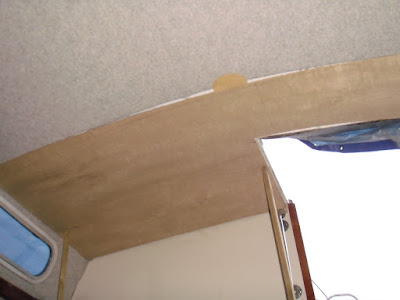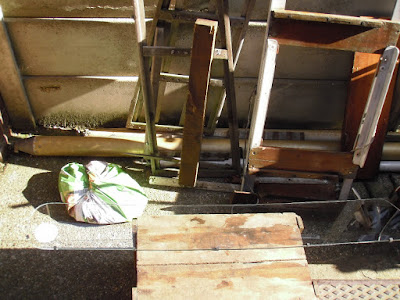I have now got the saloon windows stripped and resealed the port side one was refitted last Monday.
Last week was a short week as I had a days sailing with a friend on Friday moving his new boat from Medway Yacht Club round to Conyer. It was a pleasant days sailing, warm for the time of year, albeit an early start, up at 04.00 over to Conyer to leave my car there and then on to Lower Upnor to pick up the boat. We got away just after 07.00 and arrived in Conyer just on the high water at midday. There was not a lot of wind about so it was a case of motor sailing all the way in order to arrive in time to get up the creek to Swale Marina.
Anyway back to windows I went over to Queenborough yesterday morning and removed the starboard saloon window and stripped it and cleaned out all the old mastic from the flange photograph shows port side window starboard side was similar.
Saloon window with old mastic and bedding tape removed
The screws holding the two parts of the frame together were then removed and the two parts were gently prised apart using a sharp wood chisel by inserting it into the joint and gently twisting once the bond had broken it was just a matter of carefully pulling the two halves apart.
Screws holding the frame together
Once the frames had been split and the glazing removed, these are toughened glass unlike the fore and aft cabin windows, it was just a matter of removing the old mastic seals. I cleaned everything up with white spirit and then followed up with a good wash with hot water and detergent, Once everything had been thoroughly dried I put a good fillet of Arbosil 1098 into the channel of the lower half of the frame.
Lower half of frame with Arbosil 1098 fillet
To hold the glass central in the channel I used some short pieces of rubber channel, approximately 1/4" long, which were put over the glass before it was pressed into position in the channel. The workbench is an old wooden box and the gap between the boards is just right for holding the frame upright.
Short pieces of rubber channel attached to the glass
Glass pressed into position
Once the glass was in place I added some more pieces of rubber channel to the top half of the glass before putting a fillet of Arbosil 1098 into the channel on the top half of the frame and then pressing it into place. Once the top half of the frame was in position I replaced the fixing screws. This was followed up by an inspection to make sure that the mastic was evenly squeezed out on both sides of the channel where this had not happened it was just a matter of running the mastic gun along those areas and squeezing some more into the channel I then did a quick preliminary clean up by running a sharp wood chisel around the frame to remove the majority of the mastic that had been squeezed out. After lunch I gave the frames a wipe round with white spirit to remove any mastic, once that had been done I left the window to allow the mastic to cure.
Cleaning up with a wood chisel works fine for glass but on the other windows which have acrylic glazing I used a soft plastic scraper and then white spirit and a rag to clean them up.
Starboard window completed
The starboard window will be refitted tomorrow all that will be required will be some rain to test them that only leaves the fore hatch the acrylic glazing is OK but it is coming away from the frame which will require it to be removed and resecured using an extremely sticky double sided tape that will be the next homework job.














































